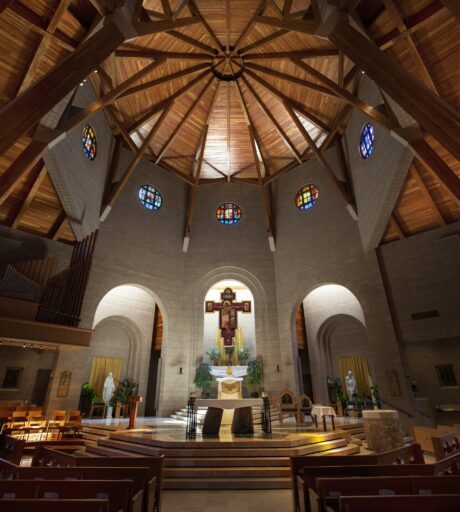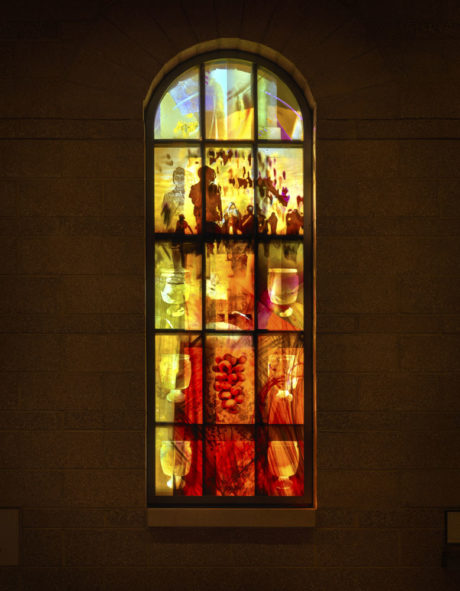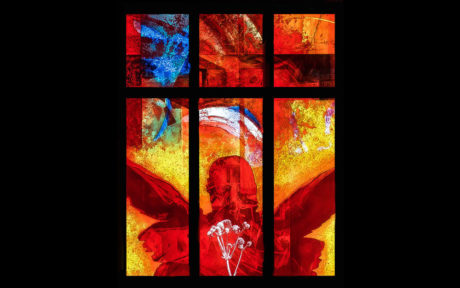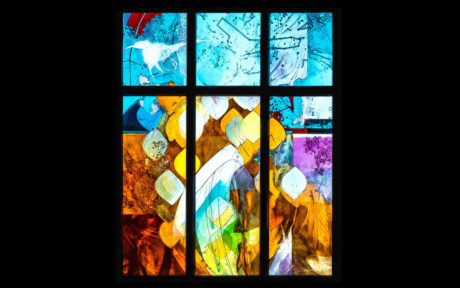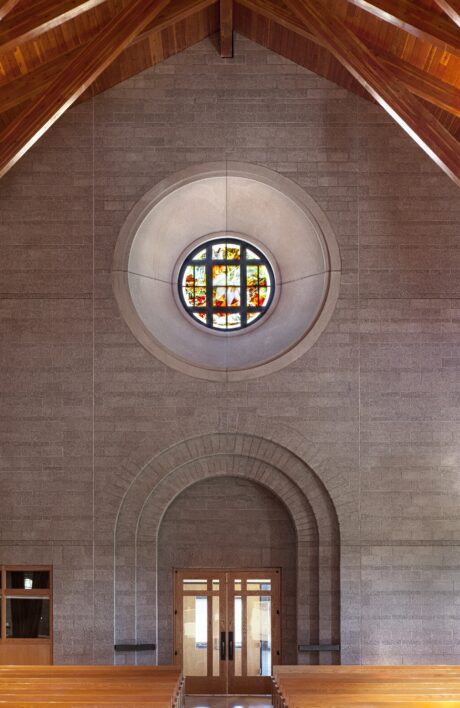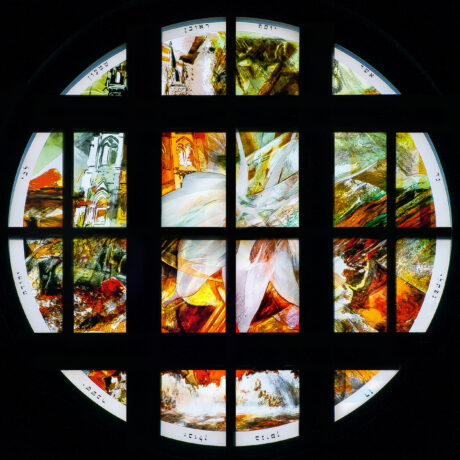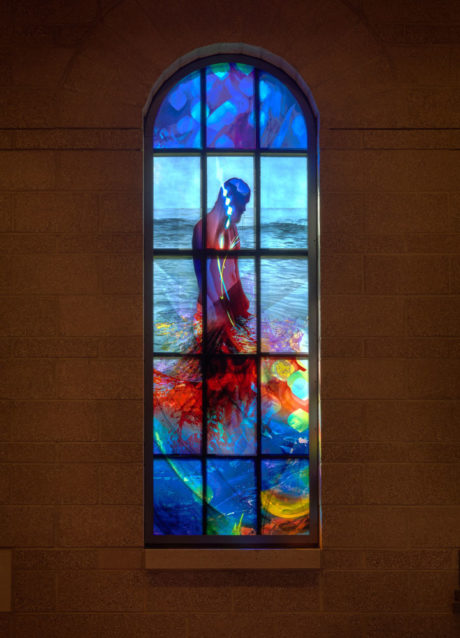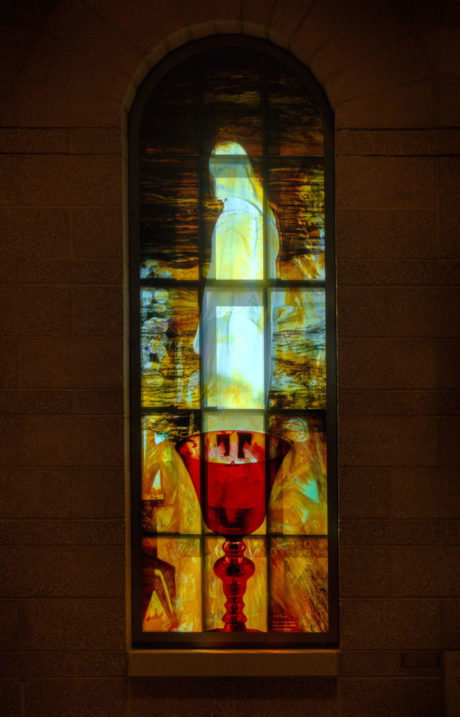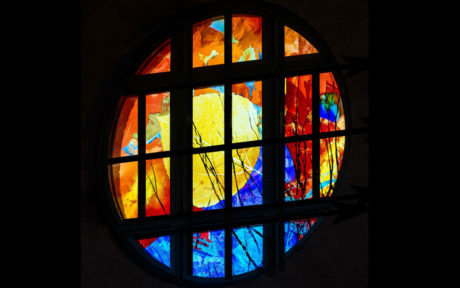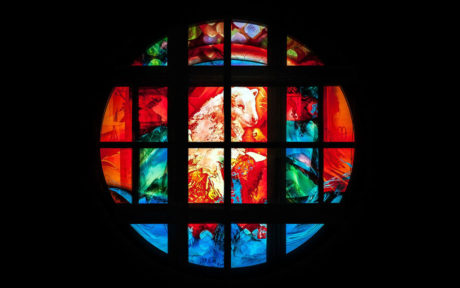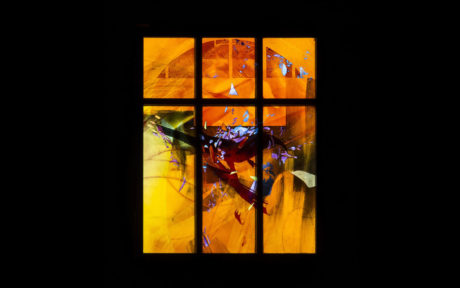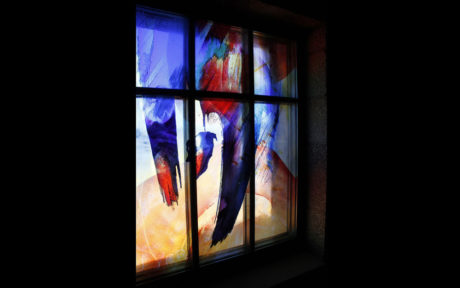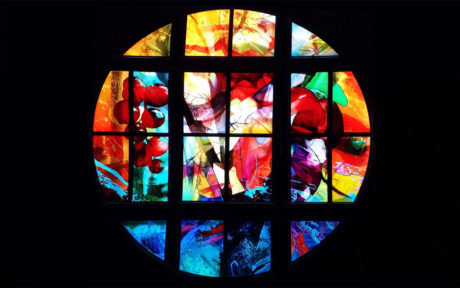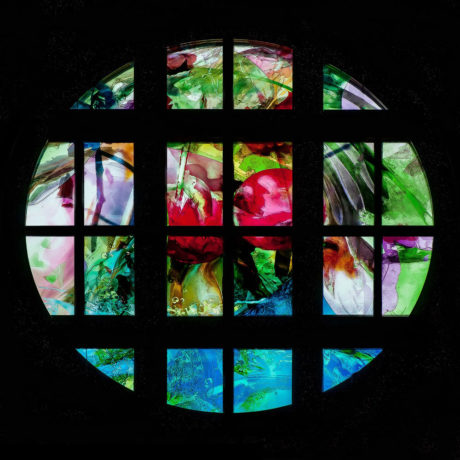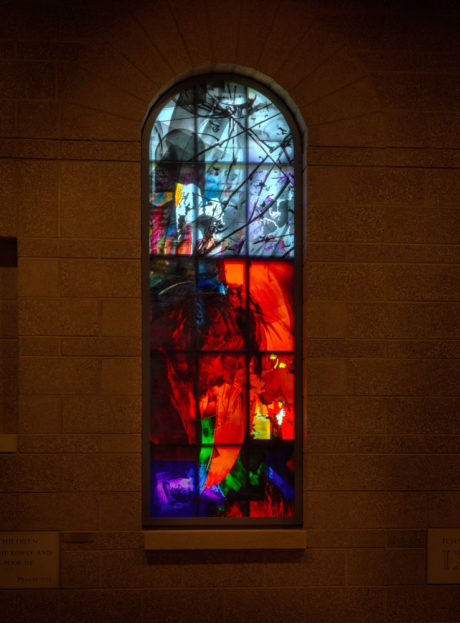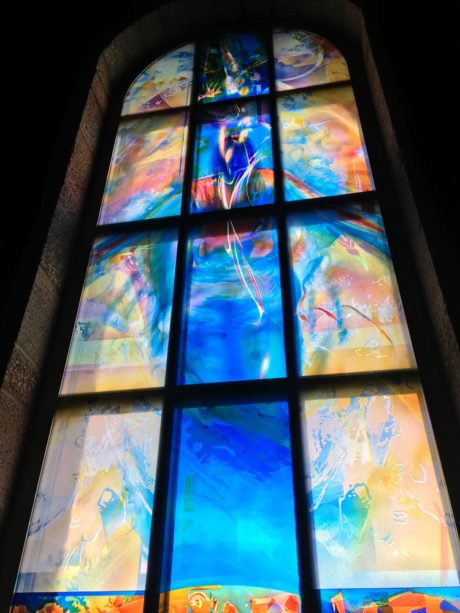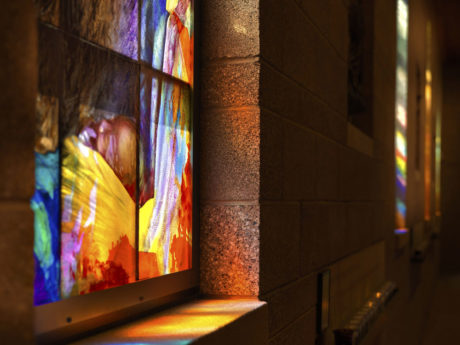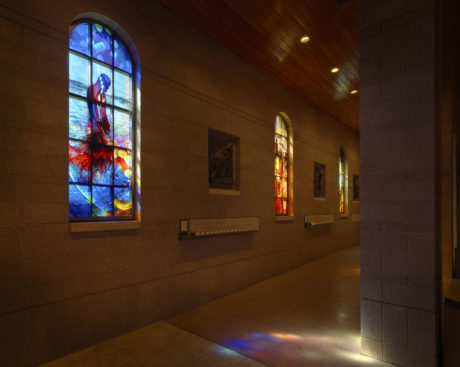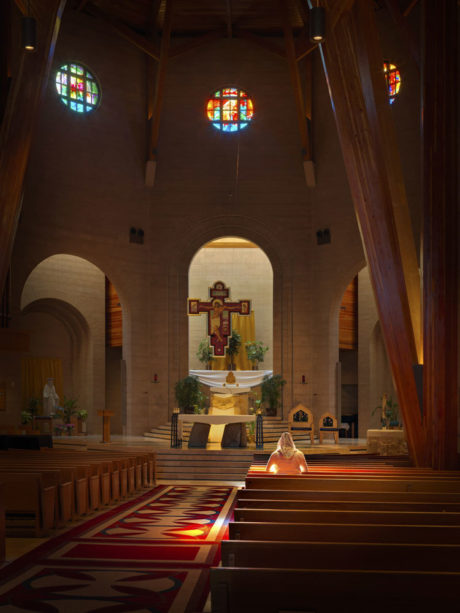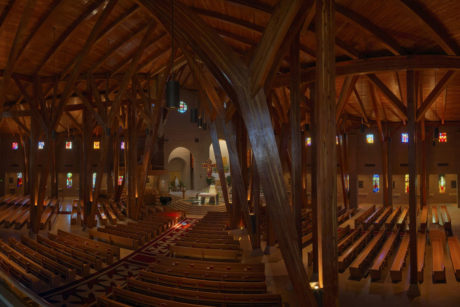Twenty-six liturgical art glass windows for Our Lady of Loreto Parish in Foxfield, Colorado are designed by Scott Parsons and created in collaboration with Derix Glasstudios in Taunusstein, Germany. The glass panels were created using hand-blown glass fired with in two or more kiln firings to layer the colors of glass. Then, using acid-etching techniques, sandblasting and vitreous-fired enamels were applied and fired to create the voluminous depth one feels when looking into these windows.
Thematically three series of windows were developed with Msgr. Edward Buelt: The Mysteries of the Rosary, the Angelic Hierarchy, and the Celestial Jerusalem. The windows were installed in 2014 and 2016.
Inspired by the Romanesque Basilica of St. Ambrose in Milan, Italy. The church is located on an elevated site east of Denver with a spectacular view of the snow-capped Rocky Mountain front range to the west. Within the sanctuary, pillars of wooden columns evoke the tall-standing cedars of Lebanon forests referred to in the Psalms.
The Artwork
The liturgical art glass panels were created using acid-etching, sandblasting and vitreous-fired enamel techniques on flashed, hand-blown glass and laminated to float carrier pieces which were in turn painted, sand-blasted, fired and tempered to create the voluminous depth one feels when looking into these windows. Breath, wind, fire, and water are all required for the very process of making glass and the imagery created for these windows.
The Mysteries of the Rosary
The Mysteries of the Rosary are portrayed in ten semi-circular aisle windows along two arcades at ground level. From north to south, the mysteries are grouped according to Pope Pius V of the 16th century: The Sorrowful Mysteries, the Glorious Mysteries, and the Joyful Mysteries; the final set of mysteries, the Luminous Mysteries, were added by Saint John Paul II in 2002. The principle design element in each liturgical art glass window explores the relationship between light and dark, especially fire and Spirit. For example, the luminous mystery of the Baptism of Christ in the river Jordon window makes reference to St. Ephrem, Hymns on Faith, 10:17—
Fire and Spirit are in the womb of her who bore you,
Fire and Spirit are in the river in which you were baptized,
Fire and Spirit are in our baptism, and in the Bread and Cup is Fire and Holy Spirit.”
And St. Justin in Dialogue with Trypho, 88—
As Jesus went down into the water, the Jordan was set ablaze.
And in St. Matthew 3:11—
He will baptize you with the Holy Spirit and fire.
A parishioner conveyed this beautiful and heartfelt sentiment to me at the blessing of these windows: “This was a holy place, now it’s a sacred place.” It is my hope that these windows do indeed help make Our Lady of Loreto a sacred place in which to prayerfully contemplate, and to liturgically and sacramentally respond in community to the work of God in our lives. For “The rosary is not a road, but a place, and it has no goal but depth. To linger in it has great compensations.” — Romano Guardini, The Rosary of Our Lady
Angels in Festal Garb
The first of ten clerestory windows (to the northeast) is the Prince of Angels, St. Michael, the defender of the church, pointing his protective sword to the west. The other nine clerestory windows depict the nine ranks of the angelic hierarchy. The angelic hierarchy is paired with the Medieval celestial hierarchy. Each level of angel corresponds to a celestial body of light, whose illumination was understood to produce a specific metal when its light touched the earth. The Moon is said to produce silver, and is the rank of intelligence of “Angel.” The rank of angel clerestory window is predominantly yellow because yellow results from painting silver-nitrate onto a carrier of earth which penetrates the glass and embeds itself throughout the glass when fired, creating a golden, amber, yellow depth-filled tone. The angelic rank of Virtues corresponds with Mars, orbits and motion. Mars is said to produce iron, so the greens and browns used throughout this window were produced by melting iron into the glass kiln. Venus is associated with copper and the rank of Principalities, hence the predominance of blue, green and red which results from firing copper in the kiln.
“We were very concerned to follow the ancient tradition and theology of the Church and in particularly Pseudo Dionysius, the most quoted Church father in St. Thomas’ ‘Summa Theologica,’” Msgr. Buelt stated in the Catholic Register. St. Thomas cautioned against representing angels in human form. “We made a very intentional design choice, an attempt to capture the very nature of a pure spiritual being, namely an angel, in accord with the teaching of Scripture and the Church Fathers.” Closest to the Throne are the “Burning Ones,” the seraphim. Pseudo Dionysius taught that one should “depict the celestial beings from fire, showing their Godlikeness, and imitation of God, as far as attainable.” Specifically, Dionysius teaches, all of the properties of fire can be said to speak of the angels, including, but certainly not limited to energy, heat and warmth, light and illumination, the capacity to consume.
Heavenly Jerusalem Windows
Beneath the Romanesque octagonal dome are installed 5 large round stained glass windows. These circular windows are inspired by the new Jerusalem described at the end of Revelations. The most prominent window in the church, aligned with the center aisle and installed above the tabernacle depicts Christ the Lamb of God seated on His throne. The other four round windows represent the four seasons and show the fruits provided by the Tree of Life in Heaven throughout the year (Rev. 21). These windows are aligned to the annual passage of the sun from north to south, hence Spring, Summer, Fall, and Winter. The River of Life can be seen flowing from the bottom of each of these windows, which for me recalls Amos 5:24, “But let justice roll down like waters. And righteousness like an ever-flowing stream.”
Wedding Window
Set to the northeast, the final rose window presents the celestial church of Denver to her divine bridegroom. In Revelation 21, when an angel takes Saint John of Patmos up to a great and high mountain to see the bride of Christ, I imagined where else could this be but to see Denver from the view at Red Rocks Ampitheater. Between the Easter sunrise services at Red Rocks Amphitheatre and attending the Christmas Eve midnight mass at the Basilica of the Immaculate Conception, these are some of my fondest places and most sacred memories of Colorado. They are both shown in this liturgical art glass window. There is a Columbine and angel (from the Dominions window), blowing her trumpet which makes reference to the Columbine as an ancient symbol for the Holy Spirit. I was so moved by the role of Our Lady of Loreto in attending to those who were affected by the recent tragedy at the Aurora movie theatre, and how sadly and tragically the word Columbine these days evokes another tragedy in Colorado, very close to where I grew up, that I just felt like this window should show something about light, and how the light can overcome darkness. Hope-filled, golden-yellow, and eternal.
